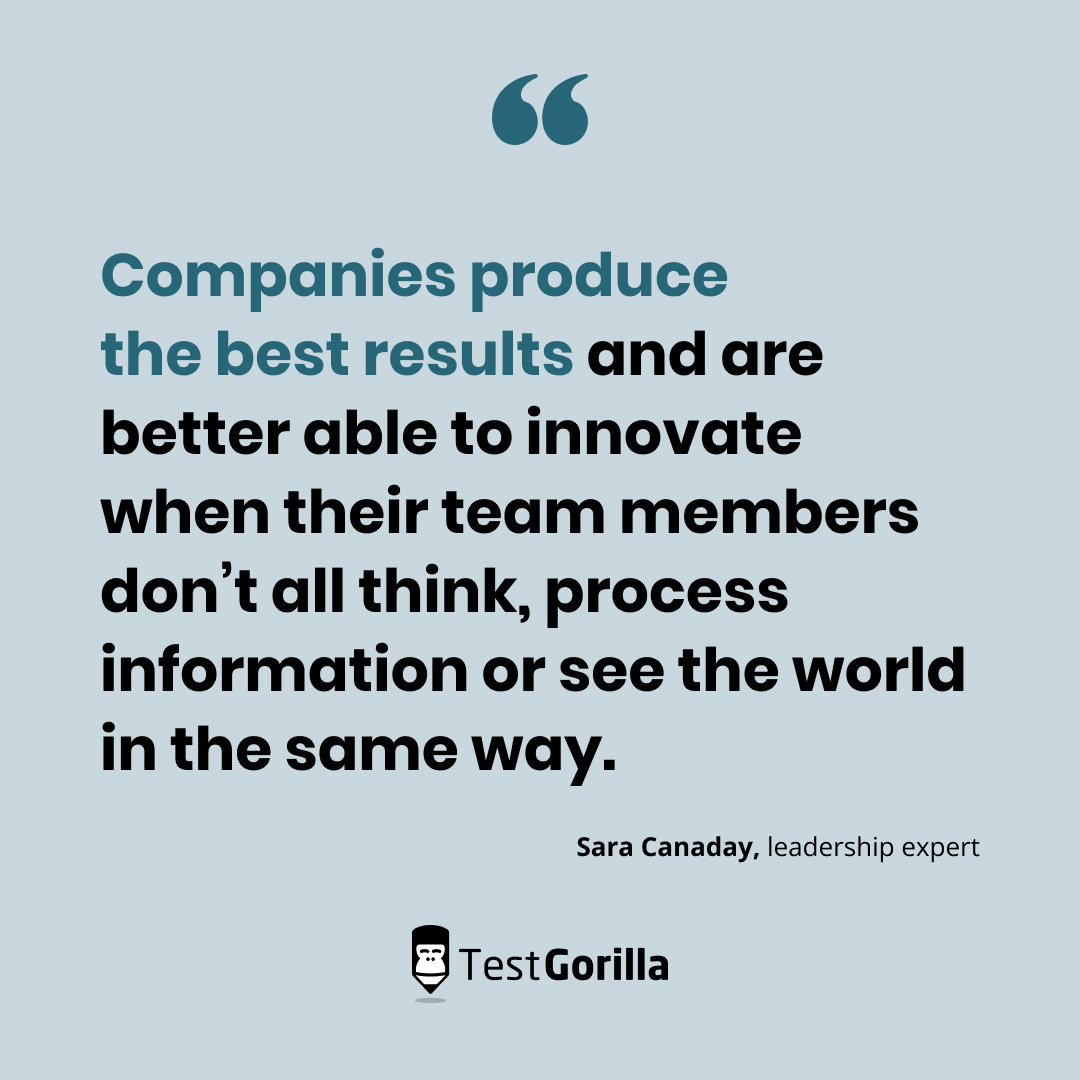One of the main problems many workforces have is a lack of cognitive diversity. In other words, everyone in the company thinks the same way.
This should not be the case because homogeneous thinking leads to a lack of fresh perspectives and alternative viewpoints, resulting in groupthink and a stagnant work environment.
How do you address this problem?
The answer: Building cognitively diverse teams.
This guide explains what cognitive diversity means in the workplace, how it benefits your organization, and actionable tips to boost cognitive diversity in your workplace culture. You'll also learn why skills-based hiring contributes to a more diverse workplace culture.
Table of contents
What is cognitive diversity and why your team needs it?
Cognitive diversity means the many different ways that team members think. It also refers to how they approach problems in their company. According to Harvard Business Review, cognitive diversity includes the ‘differences in perspective or information processing styles’.
If we go a step further, having a cognitively diverse workforce is more than just hiring employees with different perspectives, it also involves a more inclusive hiring process such as recruiting neurodivergent candidates.
Cognitive diversity includes various aspects, including the:
work styles and skill sets of employees
how they learn in the workplace
range of cognitive levels within the team
Low cognitive diversity is often caused by unconscious bias during hiring. This is because company leaders are often biased toward those that think similarly to them.
Workplace diversity may not seem like a big deal at first, but, as leadership expert Sara Canaday says, “companies produce the best results and are better able to innovate when their team members don’t all think, process information or see the world in the same way."
A lack of diverse thinking in the workplace also impedes a company’s ability to solve complex problems in innovative ways. As described by leadership coach Janine Schindler, this “lack of innovation can lead to a slow, painful death in any organization.”
What are the benefits of high cognitive diversity in the workplace?
Hiring people with varied educational backgrounds, unique perspectives, different viewpoints, and a broad range of demographic diversity has many benefits. Here are some of the ways that you can benefit from having cognitively diverse teams.
1. Improves your team’s problem solving abilities
One positive outcome to more cognitive diversity in your organization is that it tends to boost problem solving abilities within your team which leads to better work performance.
A study carried out by Harvard Business Review backs this up, with the results indicating that teams with a ‘diversity of both knowledge processes and perspective’ completed the study’s tasks faster. So, by encouraging different ways of thinking in a team, a company’s productivity can be enhanced.
There is also a ‘positive measurable correlation between teams who embrace cognitive diversity, and teams who exhibit high-performance levels’. The creativity and productivity of a diverse team are higher due to its versatility and abundance of innovative ideas.
2. Promotes an inclusive workplace
Having an inclusive team atmosphere is one of the benefits of cognitive diversity done right. When you encourage employees to share their ideas, you can create a positive environment for every team member who wants to contribute, regardless of their cultural background or sexual orientation.
With an inclusive culture permeating the workplace, you gain new ideas and creative solutions to help boost innovation within the organization.
3. Improves the company’s image for future hires
Increasing cognitive diversity is one way to improve how potential employees view your company. This sends a message of inclusivity and demonstrates a respect for different cultures. It can also attract top talent to your organization, resulting in a higher quality pool of candidates, another competitive advantage if you want to hire the best in your industry.
4. Better employee engagement
An inclusive work environment that embraces and recognizes the importance of cognitive diversity not only encourages innovation but also enhances employee engagement.
In brainstorming sessions, employees from other departments can bring unique insights and ideas to the table. When individuals feel valued, heard, and motivated to contribute their unique talents and perspectives, they are more likely to be committed to the organization's success.
5 actionable tips to promote cognitive diversity in the workplace
Promoting diversity in the workplace not only aligns with ethical principles but also makes sense from a business perspective. Here are actionable steps that organizations can implement to foster a cognitively diverse company culture.
1. Review and establish diverse hiring practices in your organization
Having a diverse recruitment process in place is a critical component in achieving cognitive diversity.
Review and modify existing recruitment processes to attract a broader range of candidates. Use inclusive language in job descriptions, expand recruitment channels, and implement blind resume screening to mitigate bias.
Additionally, diverse talent can be actively sought out by partnering with diverse organizations and attending job fairs and events
2. Provide diversity training
Offer training programs to educate employees about unconscious biases and their impact on decision-making. This helps individuals recognize and overcome biases when evaluating and interacting with colleagues, enabling greater thought diversity.
3. Acknowledge and celebrate differences
Acknowledge and celebrate diverse cultures, holidays, and milestones within the organization. You can also recognize and reward individuals with different working and learning styles but contribute to more team innovation.
4. Make way for pay equity
Encouraging pay equity and offering skills-based compensation promotes cognitive diversity. It creates a fair environment where people from different backgrounds feel motivated to contribute their unique perspectives and abilities. This approach also helps in attracting and retaining diverse talent.
5. Use pre-employment testing to build cognitively diverse teams
Another way to increase cognitive diversity is to begin using pre-employment tests to get a better idea of how candidates think. This can enhance the quality of your hires.
Online skills assessments like TestGorilla can help to increase cognitive diversity in many ways like:
Reducing bias
Skills assessments allow you to really get to know your candidates and better understand their abilities. This leads to reduced bias as an interviewer. What this means is that you are less inclined to hire a candidate simply because you think alike or have similar ideas.
Picking diverse candidates easier
Another way that online skills assessments increase cognitive diversity is that you can easily compare the results of each candidate’s tests. Online skills assessment comparisons make selecting suitable candidates easier. They help focus your hiring efforts on finding candidates who think and see things differently, rounding out the cognitive abilities in your team.
They can be taken by anyone, anywhere
With online skills assessments, the candidates you choose don’t have to reside in a specific geographic area. Hiring remotely is easier and accessing a range of cognitive abilities is also much simpler.
Recommended reading: How to hire international employees
Achieve workplace diversity and an inclusive company culture with skills testing
Remember, promoting diversity in the workplace is an ongoing effort that requires commitment, continuous learning, and constant evaluation of new challenges within your team.
Although you might be tempted to hire candidates who think like you (even if you don’t realize it), increasing cognitive diversity in your team is key to more innovation which translates to better business outcomes.
Use online skills assessments to transform your organization today. New to skills assessments? Check out our guide on how to hire the best with skills assessment tests.
You can also earn more about hiring for diversity through these guides:
Related posts
Hire the best candidates with TestGorilla
Create pre-employment assessments in minutes to screen candidates, save time, and hire the best talent.
Latest posts
The best advice in pre-employment testing, in your inbox.
No spam. Unsubscribe at any time.

Hire the best. No bias. No stress.
Our screening tests identify the best candidates and make your hiring decisions faster, easier, and bias-free.
Free resources
This checklist covers key features you should look for when choosing a skills testing platform
This resource will help you develop an onboarding checklist for new hires.
How to assess your candidates' attention to detail.
Learn how to get human resources certified through HRCI or SHRM.
Learn how you can improve the level of talent at your company.
Learn how CapitalT reduced hiring bias with online skills assessments.
Learn how to make the resume process more efficient and more effective.
Improve your hiring strategy with these 7 critical recruitment metrics.
Learn how Sukhi decreased time spent reviewing resumes by 83%!
Hire more efficiently with these hacks that 99% of recruiters aren't using.
Make a business case for diversity and inclusion initiatives with this data.





















